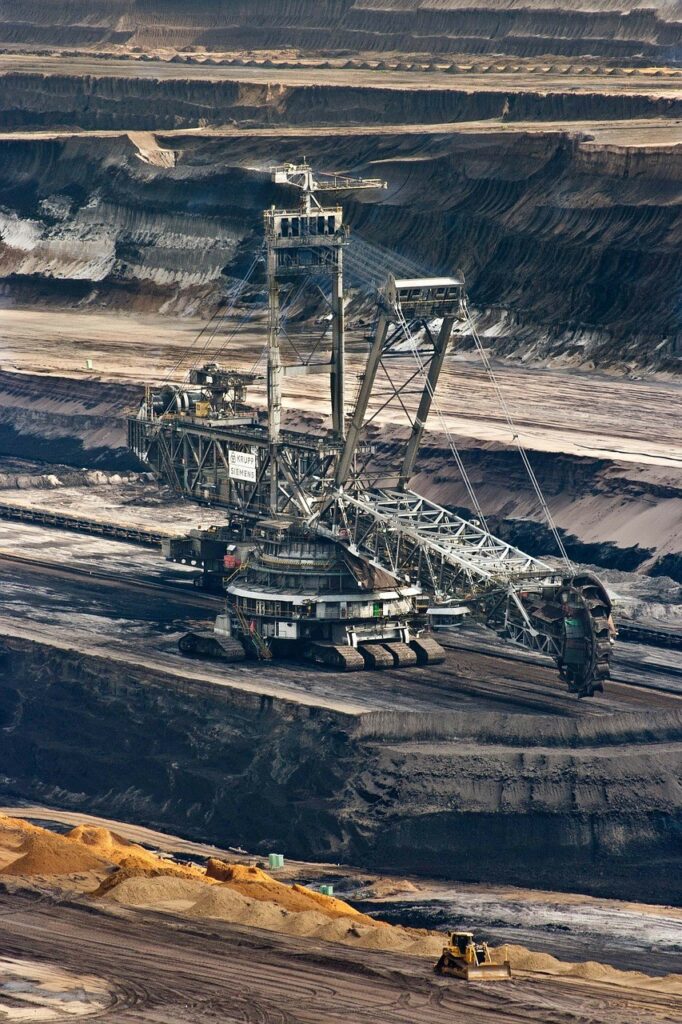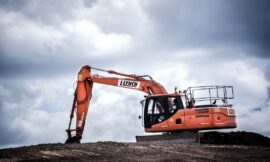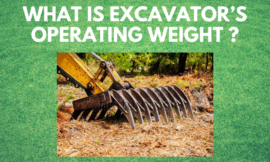Roles of a Bucket Wheel Excavator :
Introduction
There are occasions where large amounts of earth materials need to be dug up and moved.
An example is during surface mining. There, the roles of a bucket wheel excavator become prominent. In fact, a bucket wheel excavator is the world’s largest mining equipment.
What is a Bucket Wheel Excavator?
A Bucket Wheel Excavator (BWE) is a large heavy continuous cutting machine used in surface mining. The earth material can range from soft to semi hard materials such as sand, clay, and gravel. It is also used on lignite and hard coal.

Bucket wheel excavator is used to mine brown coal.
For example, it is used to mine lignite in capacities of up to 240,000 m³ (bank) per day. The digging heights can get up to 100 m with service weights of 13,500 tons.
Roles of a Bucket Wheel Excavator
The following are some specific roles of a bucket wheel excavator
Large-scale open-pit mining
Primarily, a bucket wheel excavator is used in large-scale open-pit mining operations. It works as a continuous digging machine that transfers loose materials.
Continuous overburden removal
In addition, a bucket wheel excavator can excavate thousands of tons of soft to semi-hard overburden a day. During surface mining applications, the cutting wheels strip away sections of earth.
Lignite mining
A large bucket wheel bucket excavator is most commonly used in lignite (brown coal) mining. It can continuously deliver large volumes of materials to processors. This helps in the continuous demand for lignite.
Moreover, automated systems can be added. More specific components are also designed. Thus, a bucket wheel excavator ends up being better able to deliver materials.
Material Handling
Various aspects of bulk material handling make use bucket wheel technology. For instance, bucket wheel reclaimers are used to pick up and transport materials to a processing plant. Again, stacker reclaimers have bucket wheels to help it function.
Loading and Unloading
Bucket wheels help to load and unload ships in shipyards. Materials have to be picked up and transferred from the yard to the delivery system. Furthermore, bucket chains are used to unload material from a ship’s hold.
Heap leaching processes
During heap leaching, stacks of crushed ore are constructed. Thereafter, a solvent is passed through the ore to extract valuable materials. Stacking and reclaiming technology is applied in the process of construction and removal of the heaps.

Types of Bucket Wheel Excavators
There are of three types of bucket wheel excavators.
First, there is the normal type.
Second, the C-type is there. The C-frame-type compact bucket wheel excavator is used in the Chinese Zhungeer open pit mine. It has a capacity of 3,100 m3 per hour.
Finally, there is the Compact type. This type of bucket wheel excavator typically features a two-crawler travel mechanism. In addition, it has a C frame construction and a counterweight below the discharge boom.
Features of a Bucket Wheel Excavator :
A bucket wheel excavator has certain features that make it unique.
First, it uses a large wheel with a continuous pattern of buckets. These buckets are used to extract materials as the wheel turns. This differentiates a bucket wheel excavator from other large-scale mining equipments.
Additionally, it ranks among the largest vehicles ever produced. This includes both land and sea.
For instance, the 14,200 ton Bagger 293 bucket-wheel excavator still ranks in the Guinness World Record as the heaviest land-based vehicle ever constructed.

Size of a Bucket Wheel Excavator
The size of a bucket wheel excavator depends on its intended use.
Compact BWEs
As designed by ThyssenKrupp, a compact bucket wheel excavator can have a boom length as small as six meters (20 ft); In addition, it can weigh 50 tons, and move 100 m3 (3,500 cu ft) of earth per hour.
Other larger models can have boom lengths of 80 m (260 ft), weigh 13,000 tons, and move 12,500 m3 (440,000 cu ft) of earth per hour.
The largest bucket wheel excavator – Bagger 293
The Bagger 293 can move excavations of 380,000 m3 (13,000,000 cu ft) per day and 240,000 m3 (8,500,000 cu ft) of overburden every day. It weighs 14,200 tonnes. However, the models used in the United States are usually smaller than those constructed in Germany.
It has twelve crawlers (eight at the front, four at the rear). Because of the large surface area, it does not leave deep tracks when driving over soft soil.
Built in 1978, the Bagger 293 was initially used to dig coal at the Hambach mine.
However, since 2001, it has been used at the Garzweiler open-pit lignite mine.

The following are some remarkable features of the Bagger 293 :
The Bucket Wheel
It has 18 buckets and measures 22 meters in diameter. In addition, it is driven by four 840 kW motors. Thus, the aggregate drive power of the buckets is 3,360 Kw.
This amount of drive power is equivalent to that of more than 30 compact cars. Furthermore, the “Bagger 299” has more than 120 kilometers of cabling.
The thick cables supply 30,000 volts of power to the “Bagger 288”.
The Conveyors :
They measure over three meters in width
Capacity of a Bucket Wheel Excavator
The bucket-wheel as a component can have up to 20 buckets. Furthermore, it can extend over 21 m (70 ft) in overall diameter. Each bucket has a capacity of over 15 m3 (20 cu yd) of material.
The range of operating temperatures is impressive. Generally, a bucket wheel excavator can operate in temperatures as low as −45 °C (−49 °F).
Operation of a Bucket Wheel Excavator
A bucket wheel excavator (BWE) has a superstructure that holds several more components.
There is a large, round wheel – the bucket wheel – which has a configuration of scoops attached to a boom.
The cutting wheel strips away a section of the earth called the working block.
Hoisting
This is a process where the block includes areas above and below the bench level. The bench level is the level of the machine.
Slewing
Here, the excavator reaches through a horizontal range.
Thereafter, the overburden picked up by the cutting wheel is transferred to the discharge boom.
Ultimately, the material is carried away from the machine to a spreader. The spreader may be a mobile conveyor with crawlers or a fixed conveyor system.
Thus, the excavator transfers the overburden to the spreader. The spreader takes the overburden to the dumping ground.

Automation of a Bucket Wheel Excavator
The roles of a bucket wheel excavator are further augmented by automation. This automation involves the integration of sensors and electrical components into its operation.
Such capabilities include online monitoring, GPS, and data acquisition systems.
Consequently, mining speeds become higher because some of these work are taken away from the operators.
In addition, the operators and project managers can track the data. This lets them know how much material is extracted to the conveyor belt.
Moreover, the automation system can vary the speed of the conveyor belts to allow for continuous inflow of material.
Manufacturers of Bucket Wheel Excavators
The massive gears of bucket wheel excavators are expensive to manufacture. In addition, the earlier built machines are durable even with heavy use. However, the following are some manufacturers of bucket wheel excavators.
Unex, Czech Republic, is a well known manufacturer of bucket wheel excavators.
They still possess the original casting forms. A bucket wheel excavator manufactured by Unex is used to extract diamonds from the Siberian permafrost.
A Manufacturer of Bucket Wheel Excavators includes the Ukraine Donetsk Machine-building plant NKMZ.
German companies that manufacture it include Krupp Industrietechnik and Orenstein-koppel.
The following are several other manufacturers :
- FL Smidth
● Noen
● Takraf
● FAM
● Sandvik
● Siemens
● CCMIE
● Tenova

Suppliers of bucket wheel excavators abound in Germany, Poland, Austria, China, and other countries.
Conclusion
The roles of a Bucket Wheel Excavator is indeed prominent when overburden needs to be continuously stripped. The efficiency and cost-effectiveness is valued during the mining of soft minerals.
Even with its long history of use, the bucket wheel excavator remains relevant today.





